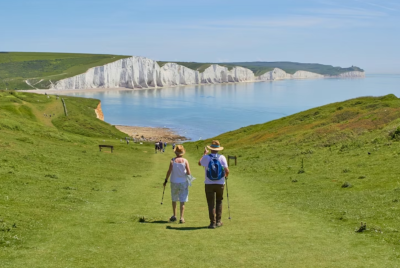US Boomer Avoids High Rent and Lives on £1,400 Benefits by Travelling in a Trailer
After Lisa's husband passed, she found herself unable to afford the £900 rent for their Palm Springs home.

The sun hasn't quite cleared the horizon when Lisa Williams steps outside her 17-foot trailer. Coffee cup in hand, she watches a family of deer pick their way across the campground. This wasn't the retirement she planned, but at 64, Lisa has found an unexpected answer to America's housing nightmare.
'Some mornings I still can't believe this is my life,' she says, gesturing at the Utah landscape surrounding her temporary home at Green River State Park. 'It's not what my husband and I dreamed about, but there's something pretty magical about it.'
When Lisa lost her husband in 2014, she didn't just lose her partner of thirty years—she lost her financial stability, her home, and the retirement they'd carefully planned together. What she found instead was "work camping"—trading part-time labour in America's state and national parks for a free place to park her trailer.
Lisa belongs to a growing tribe of older Americans who've turned to the road not from wanderlust but necessity, as soaring rents and stagnant pensions create a perfect storm that's left many facing homelessness in their golden years.
Tragic Loss Transforms Into a New Path in Life
After Lisa's husband passed away, she, then 54 and working as a housekeeper, found herself unable to afford the £900 ($1,200) rent for their Palm Springs home. Within six months, she was forced to leave.
She spent the next seven years shuffling between makeshift homes. First, she lived near her daughter in Washington in a backyard trailer and tiny house with nothing but a hose for running water. Williams had to shower at the gym during this time. Then, she moved to a small apartment in Las Vegas to be close to her son.
Lisa's life was far from the adventurous dream she had once envisioned, and escalating rents made stability feel increasingly out of reach. When her Las Vegas landlord raised her rent from £585 ($780) to over £750 ($1,000) in just two years, she knew she needed a lifestyle change, foregoing city lights for iconic natural landmarks.
What Work Camping Entails— Is It For You?
After her epiphany, Williams spoke with a friend who told her about an exciting alternative to traditional work— parks offer employees and volunteers spaces for their trailers or RVs in exchange for their services. Interested in the prospect, Williams contacted the Mojave National Preserve, which was only an hour away.
They told her about the opportunity to 'work camp' there, which would involve working 30 hours weekly, selling merchandise and helping visitors navigate the premises. In exchange, she was offered a free RV site, utilities including WiFi, sewer services and access to communal facilities such as laundry. Left with little choice, Lisa jumped at the chance— she bought a 17-foot secondhand travel trailer and began her new chapter as a work camper.
Lisa Speaks On Her New, Free, Nomadic Life
Ever since she took the leap, Lisa has not looked back. She spends her winters in the warm deserts of the Southwest and her summers in cooler regions such as Utah's Green River State Park, where she's currently employed part-time. Though she enjoys her work, Williams can't afford to retire. She survives on £1,323 ($1,764) in Social Security survivor benefits, occasional park wages, and a £825 ($1,100) life insurance payment from her late husband.
In her off-hours, she hikes, kayaks, mountain bikes, and socialises with fellow travellers and park staff, who have helped her cope with the loneliness she felt after losing her husband. Williams calls her new life her 'passion.'
Theoretically, she could move in with her daughter in Sacramento if needed. Her family has offered to help care for her as she ages. But for now, she's determined to remain independent, on her own terms. This winter, she hopes to stay in Joshua Tree National Park or Death Valley.
'I did this because I didn't feel like I had any options, but I wouldn't go back,' she said. It's not like she can stop, anyhow, as she cannot afford to retire. Having grown used to a nomadic life, Lisa worries she would grow bored if she moved back into a regular home. 'I would probably get a job watering plants at Lowe's or greeting people at Walmart,' she reflected. 'But I don't want to do that.'
Lisa hopes her stories inspire others to take a chance on a new path, telling Business Insider: 'I want people to know that they do have options, and to just get out there, think out of the box. I know at the end of my life, I will have no regrets. I've been to amazing places and I've seen amazing things, and that's just been in the last few years.'
Though her story ends on an optimistic note, Lisa's plight— facing homelessness and being unable to retire— is, unfortunately, all too common in today's America.
Mobile Homes: A Living Cost Crisis Craze
As living costs skyrocket, elderly Americans find themselves increasingly unable to afford to retire. This situation is only expected to worsen, with experts warning of a 4.4% increase in housing expenses between 2024 and 2025. These hikes are even worse for the 28% of seniors who live and pay bills with a single income. Unable to keep up with the costs, 25% of adults aged 65 and older in the US are still employed, and 6% of retirees are considering returning to work in 2025. Notably, 22% of working seniors have rejoined the workforce after retirement, primarily due to financial struggles.
However, many are simply unable to make ends meet— homelessness in the US reached a record high in 2023 and surged by 18% in 2024, as reported by the federal government. Half of these individuals are 50 or older.
Compared to eviction and nights on the street, saving thousands on rent by investing in a mobile home can be an attractive option. Currently, there are 8.5 million mobile homes in the US, providing housing for over 20 million people. This represents approximately 6.4% of the country's housing sector. As housing prices rise, this number is only expected to increase.
In a nation where housing has become a crisis rather than a right, Lisa and her fellow work campers have stumbled upon something profound—that with resilience, creativity and an open heart, home isn't always where you planned it would be. Sometimes it's simply where you park it.
© Copyright IBTimes 2025. All rights reserved.






















